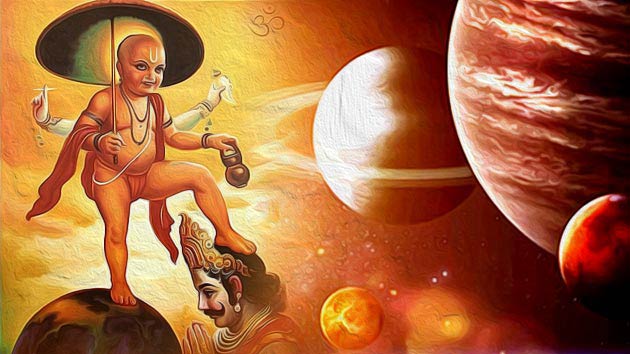- Courtesy : His Holiness Sri Vishvapriya Teertha Sripadaru
- Compilation : Dr || Vamshikrishnacharya Purohit
- Translation : Sandesh Upadhyaya K.
In the previous issues, we discussed how Bali Chakravarti prepared for battle with the encouragement of sage Shukracharya and Sri Prahlādarajaru. Let us now explore and try to adopt the spiritual significance of these events in our lives.
We shall now consider Bali as the soul (jīva) in one’s life. The reason being, the jīva is meant to sacrifice himself. Of the nine types of devotion (navavidha bhakti) stated by Sri Prahlādarajaru, the last one is Ātmanivēdanaṁ. This term can be interpreted in three ways. Firstly, Ātmani + vēdanaṁ, where Ātmani means within oneself, and vēdanaṁ is understanding the existence of the Lord. Secondly, Ātma + nivēdanaṁ, where Ātma implies the self, and nivēdanaṁ means submission to the Lord. Lastly, Ātmani + vēdanaṁ, where Ātmani means inherent in the self, and vēdanaṁ refers to keeping the several pains and miseries within oneself without sharing it with others.
When we face problems in this mundane world, it burdens the mind. In order to rid ourselves of the burden, we share our problems with others and transfer the weight onto them. Having done so, one states that the mind feels lighter. Theologists assert that it is not the right thing to do. Rather, our pains should be contained within ourselves, tolerated and then hymns of the Lord must be sung. This would qualify as the greatest form of devotion. The other eight forms of devotion are easy. The last form of Ātmanivēdanaṁ does not come to us so easily. Probably, that is why Sri Prahlādarajaru mentioned Ātmanivēdanaṁ at the end.
These wise words from Sri Prahlādarajaru stem from what he experienced at every moment of his life. Bound by the order of Shukracharya who was the guru of his father Hiranyakashipu, Sri Prahlādarajaru left for the Āśrama of Śaṇḍa-Marka (children of Shukracharya) for further study. He was aware that their preaching was not right, yet he endured that sadness. Eventually one day, he informed the other disciples at the Āśrama that the teachings of their gurus were incorrect. This clearly indicates that Sri Prahlādarajaru had performed Śravaṇaṁ before itself. He imparted proper understanding to the others. It is a great form of devotion to worship the Lord by keeping the pain within oneself. That is why he mentioned Ātmanivēdanaṁ at the end.
Scholars say that the awareness of the jīva must scale to that level. This methodology fits perfectly in spirituality. After we have attained knowledge in an abstract form (parōkṣajñānāvasthe) the next horizon to be explored by humans is as follows: Ātmani + vēdanaṁ = understanding of the Lord i.e., realization; later, Ātma + nivēdanaṁ = submitting oneself to the Lord with devotion; and Ātmani + vēdanaṁ = suffering the pain which arises from Prārabdhakarma (past actions that are affecting the current life). That is why Sri Prahlādarajaru comprehensively mentions Ātmanivēdanaṁ at the end.
Therefore the jīva in every body is a Bali. As a king travels around his kingdom for the welfare of his subjects like a chakra (wheel), he is known as Chakravarti. Likewise, the term Chakravarti is also befitting for the jīva, for it travels within the body like a wheel. Our body has six chakras starting from the navel to the head. Every soul should be aware of these six chakras. The jīva should awaken the chakras like kundalini through diligent spiritual practice. When he enters these chakras, he can see the Lord. He will attain realization. When a jīva awakens these chakras and connects with them, he is called a Chakravarti. Mere presence of these chakras in one’s body does not suffice. The one who undertakes rigorous spiritual practice involving the chakras alone qualifies to be called a Chakravarti. Therefore, the jīva is Bali Chakravarti too.
Bali desired for Indra’s position. He wished to rule the heavens. That means his aspired for the higher realms. Likewise, even the jīva should always aim to reach the higher world. To realize the Lord, one must go to an elevated position. So when Bali was longing for an elevated position, he got the presence of Shukracharya. This also indicates Shukradasa (good times).
From Shukra(dasa), he got a wonderful chariot. The chariot also implies an immaculate body. Does one require a fortune greater than all the senses of the body functioning well? Materially, when a lot of wealth accrues to a person at once, we say Shukradasa (good time) has begun. In the same way, internal wealth is having a healthy body with well-functioning organs. In this modern era, during pregnancy, if the baby is detected with any defects in the sensory organs or has a disease, there is a system of healing the baby while still in the womb itself. When a baby thus treated, is born healthy, we say “the baby is born with the endowment of Shukradasa”.
Similarly, the soul named Bali has obtained this body which is a wonderful chariot as a result of Shukradasa (good times obtained from planet Venus). That too is a golden chariot. Gold is termed as Suvarṇa in Sanskrit, which translates to good color (Su+varṇa). The body should be of good color. It means that when the baby grows, it should speak some good words from the mouth and the body is the facilitator. Hence we can summarize that, by the power of Shukra, the grace of the Guru, seated in the golden chariot called the body, the soul named Bali Chakravarti should always aspire to see the Lord, by continually aiming to reach the exulted position throughout the journey of life.
Image Courtesy: http://media.webdunia.com/_media/hi/img/article/2017-07/04/full/1499166579-1909.jpg
A seeker of Madhva philosophy. Hails from Rupyapeeta (Udupi).
|| विष्णो: सर्वोत्तमत्वं च सर्वदा प्रतिपादय ||
(Hari sarvothama Vayu jeevothama tatva)

Pingback: Sarvamoola Patrike : July-August 2019 – Sarvamoolapatrika
Excellent presentation. Please continue the good effort
Atma nivedhanam explanation very nice. Thanks for sharing